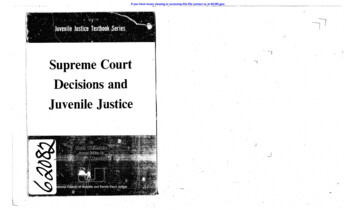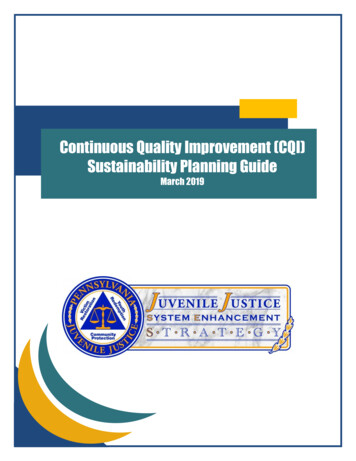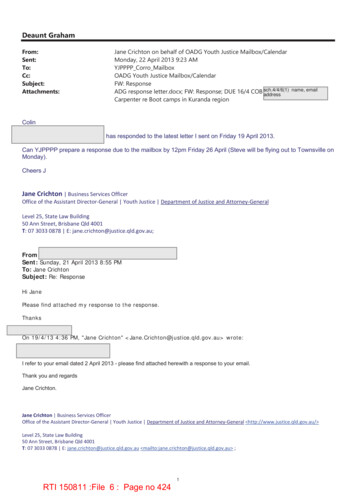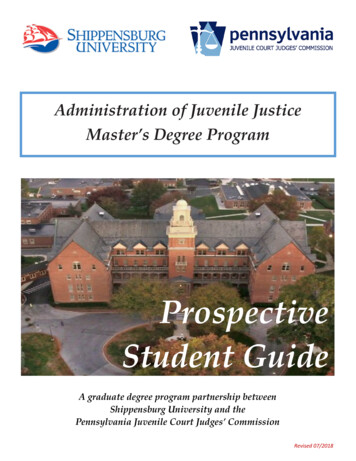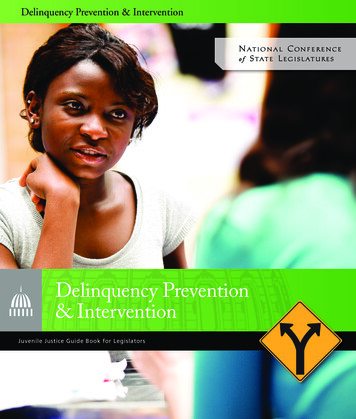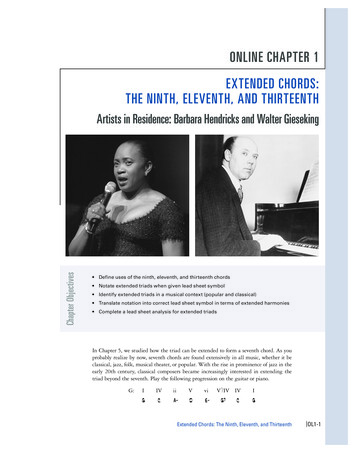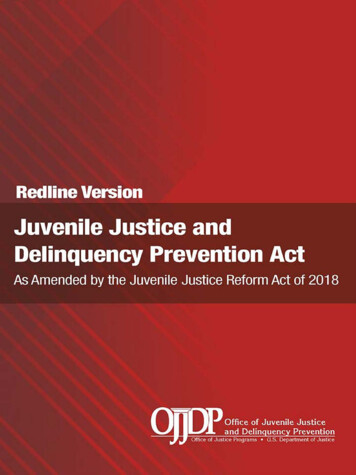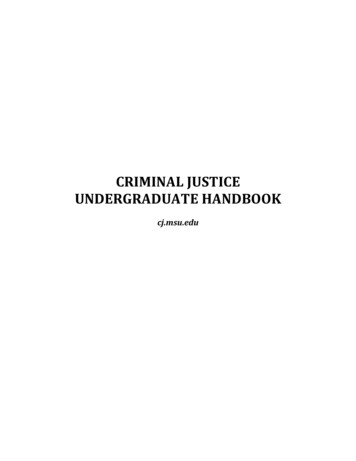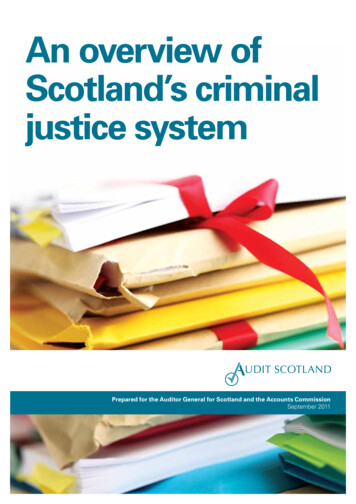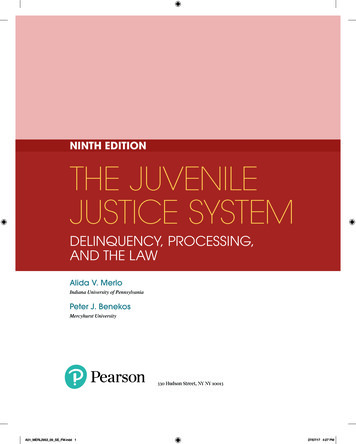
Transcription
NINTH EDITIONTHE JUVENILEJUSTICE SYSTEMDELINQUENCY, PROCESSING,AND THE LAWAlida V. MerloIndiana University of PennsylvaniaPeter J. BenekosMercyhurst University330 Hudson Street, NY NY 10013A01 MERL2953 09 SE FM.indd 127/07/17 4:27 PM
Editorial Director: Andrew GilfillanProduct Manager: Gary BauerProgram Manager: Tara HortonEditorial Assistant: Lynda CramerDirector of Marketing: David GesellSenior Marketing Manager: Mary SalzmanSenior Marketing Coordinator: Alicia WozniakSenior Marketing Assistant: Les RobertsProject Management Team Lead: JoEllen GohrProject Manager: Jessica H. SykesProcurement Specialist: Deidra SkahillSenior Art Director: Diane ErnsbergerCover Designer: CenveoCover Art: Alexandra N. AshleyMedia Project Manager: April ClelandFull-Service Project Management: Mohinder Singh/iEnergizer Aptara , Inc.Composition: iEnergizer Aptara , Inc.Printer/Binder: Courier/KendallvilleCover Printer: Courier/KendallvilleText Font: Minion ProCover photograph courtesy of Alexandra N. AshleyCopyright 2017, 2016, 2013, 2010, 2007, by Pearson Education, Inc. and its affiliates, All rights reserved.Manufactured in the United States of America. This publication is protected by Copyright, and permission should beobtained from the publisher prior to any prohibited reproduction, storage in a retrieval system, or transmission in any formor by any means, electronic, mechanical, photocopying, recording, or likewise. To obtain permission(s) to use materialfrom this work, please submit a written request to Pearson Education, Inc., Permissions Department, 221 River Street,Hoboken, New Jersey 07030.Library of Congress Cataloging-in-Publication DataNames: Merlo, Alida V., author. Benekos, Peter J., author.Title: The juvenile justice system : delinquency, processing, and the law/Alida V. Merlo, Indiana University of Pennsylvania; Peter J. Benekos,Mercyhurst University.Description: Ninth edition. Hoboken, New Jersey: Pearson, [2019] Includes bibliographical references and index.Identifiers: LCCN 2017028492 ISBN 9780134812953 (alk. paper) ISBN 0134812956 (alk. paper)Subjects: LCSH: Juvenile justice, Administration of—United States. Juvenile courts—United States. LCGFT: Textbooks.Classification: LCC KF9779 .C425 2019 DDC 345.73/08—dc23LC record available at https://lccn.loc.gov/20170284921 17ISBN 10: 0-13-481295-6ISBN 13: 978-0-13-481295-3A01 MERL2953 09 SE FM.indd 227/07/17 4:27 PM
To Kevin and AlexandraTo PatA01 MERL2953 09 SE FM.indd 327/07/17 4:27 PM
A01 MERL2953 09 SE FM.indd 427/07/17 4:27 PM
Brief ContentsChapter 1An Overview of Juvenile Justice in the United StatesChapter 2The History of Juvenile Justice and Origins of the Juvenile CourtChapter 3Theories of Delinquency and Intervention ProgramsChapter 4The Legal Rights of JuvenilesChapter 5Juveniles and the PoliceChapter 6Intake and Preadjudicatory ProcessingChapter 7Prosecutorial Decision Making in Juvenile JusticeChapter 8Classification and Preliminary Treatment: Waivers and OtherAlternatives 229Chapter 9The Adjudicatory Process: Dispositional AlternativesChapter 10Nominal Sanctions: Warnings, Diversion, and Alternative DisputeResolution 301Chapter 11Juvenile Probation and Community-Based CorrectionsChapter 12Juvenile Corrections: Custodial Sanctions and Aftercare13168106143180205266325357v A01 MERL2953 09 SE FM.indd 527/07/17 4:27 PM
A01 MERL2953 09 SE FM.indd 627/07/17 4:27 PM
ContentsP R E FAC ExiiiABOUT THE AUTHORSChapter 1xixAn Overview of Juvenile Justice in the United StatesLearning Objectives 1Introduction 2The Juvenile Justice System 2Who are Juvenile Offenders?Parens Patriae 5Types of Juvenile Offenders3 Parens Patriae14 Modern Interpretations of6Juvenile Delinquents and Delinquency6 Status Offenders9Some Important Distinctions between Juvenile and Criminal CourtsThe Juvenile Justice Process 1615The Ambiguity of Adolescence and Adulthood 16 Being Taken intoCustody 17 Juveniles in Jails 17 Referrals 18 Intake 21 Alternative Prosecutorial Actions 23 Adjudicatory Proceedings 24 JuvenileDispositions 24 Juvenile Corrections 27 Juvenile Aftercare 28Summary 28Key Terms 29Critical Thinking Application ExercisesChapter 230The History of Juvenile Justice and Origins of the Juvenile CourtLearning Objectives 31Introduction 32The History of Juvenile Justice and Juvenile Courts 3431Workhouses and Poor Laws 35 Indentured Servants 36 Hospital of SaintMichael 37 The Child Savers and Houses of Refuge 37 Ex Parte Crouse(1839) 38 Reform Schools and People ex rel. O’Connell v. Turner (1870) 38 Community-Based Private Agencies 39 Truancy Statutes 39 The Illinois Juvenile Court Act 39 Juveniles as Chattel 41 Children’sTribunals 41 Informal Welfare Agencies and Emerging Juvenile Courts 42 From Gemeinschaft to Gesellschaft and Reconceptualizing Juveniles 42 SpecializedJuvenile Courts 42 Children and Due Process 44 The IncreasingBureaucratization and Criminalization of Juvenile Justice 44Measuring Juvenile Delinquency45The Uniform Crime Reports and the National Crime Victimization SurveyAdditional Sources 48Violence and Nonviolence: Career Escalation?45 52School Violence 52 At-Risk Youth and the Pittsburgh Youth Study 55 Kids WhoKill 56 Trends in Juvenile Violence 58 Career Escalation 60vii A01 MERL2953 09 SE FM.indd 727/07/17 4:27 PM
Female Versus Male Delinquency60Profiling Female Juvenile Offenders 63 Trends in Female JuvenileOffending 64 Myths and Misconceptions: Changing Views of Juvenile FemaleOffenders 64Summary 66Key Terms 66Critical Thinking Application ExercisesChapter 367Theories of Delinquency and Intervention ProgramsLearning Objectives 68Introduction 69Classical and Biological Theories 70Classical Theory70 Biological TheoriesPsychological Theories7174Psychoanalytic TheorySociological Theories6874 Social Learning Theory7576The Concentric Zone Hypothesis and Delinquency 76 The Subculture Theory ofDelinquency 78 The Anomie Theory of Delinquency 80 LabelingTheory 81 Bonding Theory 82 Agnew’s General Strain Theory 83Additional Theoretical Explanations of DelinquencyIntegrating Theories 87An Evaluation of Explanations of Delinquent ConductTheories 88Theories, Policies, and Intervention StrategiesModels for Dealing with Juvenile OffendersCommunity Interventions 100Summary 104Key Terms 104Critical Thinking Application ExercisesChapter 487 Toward an Integration of8991 Delinquency Prevention Programs and105The Legal Rights of Juveniles 106Learning Objectives 106Introduction 107Original Juvenile Court Jurisdiction: Parens PatriaeThe Hands-Off Doctrine85108108Changing Legal Rights of Juveniles113Landmark Cases in Juvenile JusticeJuvenile Court 121The Death Penalty for Juveniles113 Juvenile Rights and the Transformation of the128Rationale For and Against the Death Penalty 130 The Supreme Court Death PenaltyCases for Juveniles 132 Public Sentiment About the Death Penalty for Juveniles 140Summary 141Key Terms 142Critical Thinking Application ExercisesChapter 5142Juveniles and the Police 143Learning Objectives 143Introduction 144Police Discretion: Use and Abuse 145Roles and Expectations of Police OfficersPolice and Gangs146149Juvenile Gang Units in Police DepartmentsStatus 151 Female Gangs 155Contents149 Youth Gangs and Minorityviii A01 MERL2953 09 SE FM.indd 827/07/17 4:27 PM
Handling Juveniles158Juvenile Response to Police Officer ContactsOffenders and Juvenile Delinquents 169Redefining the Role of Police with YouthSchool Resource Officers162 Status173174 Police Probation PartnershipsSummary 179Key Terms 179Critical Thinking Application ExercisesChapter 6158 Arrests of Juveniles177179Intake and Preadjudicatory ProcessingLearning Objectives 180Introduction 181What Is Intake? 181180The Discretionary Powers of Intake Officers 184 The Increasing Formalization ofIntake 188 The Emphasis on Greater Accountability 189 Intake Proceedings:Where Do We Go from Here 189Legal and Extralegal Factors That Influence How Juvenile Offenders Are TreatedLegal Factors192 Extralegal Factors192194Preliminary Decision Making: Diversion and Other Options199Diverting Certain Juveniles from the System 199 How Should We Deal with ChronicViolent Offenders? 200 The Search for Effective Treatment and CommunityServices 200 Getting Tough with Persistent Offenders 200 Is There Too MuchJuvenile Incarceration? 202 Assessment of Guardianship? 202Summary 203Key Terms 203Critical Thinking Application ExercisesChapter 7203Prosecutorial Decision Making in Juvenile JusticeLearning Objectives 205Introduction 206The Changing Prosecutorial Role in Juvenile Matters 206205Modifying Prosecutorial Roles by Changing the Standard of Proof in JuvenileProceedings 208 Eliminating the Confidentiality of Juvenile Court Proceedings andRecord Keeping 209 Open Juvenile Court Proceedings 211The Speedy Trial Rights of Juveniles211Court Delays 211 Time Standards in Juvenile Court for Prosecutors and OtherProfessionals 214 Why Should the Juvenile Justice Process Be Accelerated? 219The Advocacy Role of Defense Attorneys and Public Defenders for Juveniles221Attorneys for Juveniles as a Matter of Right 222 Defense Counsel and Ensuring DueProcess Rights for Juveniles 223 Are Attorneys Being Used More Frequently by JuvenileDefendants? 224 Does Defense Counsel for Juveniles Make a Difference in Their CaseDispositions? 225 Defense Counsel as Guardians Ad Litem 226 JuvenileOffender Plea Bargaining and the Role of Defense Counsel 226Summary 227Key Terms 227Critical Thinking Application ExercisesChapter 8227Classification and Preliminary Treatment: Waivers and OtherAlternatives 229Learning Objectives 229Introduction 230Seriousness of the Offense and Waiver Decision Making 230Seriousness of Juvenile Offending 230 Separating Status Offenders from DelinquentOffenders 231 Juvenile Court Adjudications for Status Offenders 232 The Use ofContentsix A01 MERL2953 09 SE FM.indd 927/07/17 4:27 PM
Contempt Power to Incarcerate Nondelinquent Youth 232 Delinquent Offenders andJuvenile Court Dispositions 234 Transfers, Waivers, andCertifications 234 Waiver Decision Making 242Types of Waivers243Judicial Waivers 243 Direct File 245 Statutory Exclusion 246 DemandWaivers 247 Other Types of Waivers 247 State Variations in Waiver Use 247Waiver and Reverse Waiver HearingsWaiver Hearings250250 Reverse Waiver HearingsImplications of Waiver Hearings for Juveniles250251Benefits of Juvenile Court Adjudications 252 Unfavorable Implications of JuvenileCourt Adjudications 254 Jury Trials 255 Implications of Criminal CourtProcessing 255 Jury Trials as a Matter of Right for Serious Offenses 255Blended Sentencing Statutes259The Juvenile-Exclusive Blend 262 The Juvenile-Inclusive Blend 262 The JuvenileContiguous Blend 262 The Criminal-Exclusive Blend 262 The Criminal-InclusiveBlend 263Summary 263Key Terms 264Critical Thinking Application ExercisesChapter 9265The Adjudicatory Process: Dispositional AlternativesLearning Objectives 266Introduction 267Nature of the Offense and Offender 267The Nature of the Offense267 First-Offender or Repeat Offender?Aggravating and Mitigating CircumstancesAggravating Circumstances266269271272 Mitigating CircumstancesJuvenile Risk Assessments and Predictions of Dangerousness273274Dangerousness and Risk 275 Needs Assessment and ItsMeasurement 275 Selective Incapacitation 276 Common Elements of RiskAssessment Instruments 277 The Functions of Classification 280 Risk Predictionfrom Arizona and Florida 281Predisposition Reports291Victim-Impact Statements in Predisposition ReportsSummary 300Key Terms 300Critical Thinking Application ExercisesChapter 10298300Nominal Sanctions: Warnings, Diversion, and Alternative DisputeResolution 301Learning Objectives 301Introduction 302Nominal Dispositions Defined 302Diversion 303Benefits and Limitations of Diversion 304 Diversion Programs forJuveniles 305 Implications of Diversion Programs for Juveniles 306Teen Courts308The Use of Teen Courts 309 Teen Court VariationsCourts 313 Some Examples of Teen Courts 313Day Reporting Centers311 The Success of Teen319Goals and Functions of Day Reporting CentersCenter 320Contents319 Example of a Day Reportingx A01 MERL2953 09 SE FM.indd 1027/07/17 4:27 PM
Alternative Dispute Resolution321The Restorative Justice Panel322 Balanced and Restorative JusticeSummary 323Key Terms 324Critical Thinking Application ExercisesChapter 11324Juvenile Probation and Community-Based CorrectionsLearning Objectives 325Introduction 326Standard Probation for Juveniles 326Restitution332 The Success of Standard Juvenile ProbationIntermediate Sanctions325333337Intermediate Punishments for Juvenile OffendersProbation 338Case Supervision323337 Juvenile Intensive Supervised342Case Supervision Planning342 Community-Based AlternativesMonitoring and Supervisory MethodsElectronic Monitoring346 Home Confinement or House ArrestOther ISP Program Conditions344346351352Restitution, Fines, Victim Compensation, and Victim–OffenderMediation 354 Community Service 355Summary 355Key Terms 356Critical Thinking Application ExercisesChapter 12356Juvenile Corrections: Custodial Sanctions and AftercareLearning Objectives 357Introduction 358Goals of Juvenile Corrections 358357Deterrence 359 Rehabilitation and Reintegration 359 Retribution andPunishment 359 Incapacitation and Control 360Current Juvenile Custodial Alternatives360Nonsecure Confinement 360 Secure ConfinementNonsecure and Secure Confinement 370Juvenile Aftercare364 Persistent Problems of376Juvenile Aftercare Defined376 Recidivism and Aftercare or Parole RevocationSelected Issues in Juvenile Corrections379383The Privatization of Juvenile Corrections 385 Classification of JuvenileOffenders 387 Evidence-Based Practice 387 Juveniles Held in Adult Jails orLockups 388 Juveniles in Adult Prisons 389Summary 390Key Terms 391Critical Thinking Application ExercisesGLOSSARY000BIBLIOGRAPHYCASE INDEX392000000NAME INDEXSUBJECT INDEX000000Contentsxi A01 MERL2953 09 SE FM.indd 1127/07/17 4:27 PM
A01 MERL2953 09 SE FM.indd 1227/07/17 4:27 PM
P re fa c eThe Juvenile Justice System: Delinquency, Processing, and the Law, Ninth Edition, is acomprehensive study of the juvenile justice system. The book examines how juvenileoffenders are defined and classified, and it utilizes the current literature to illustrate thesignificant stages of juvenile processing and recent changes and developments in juvenilejustice. The book explains the system’s response historically and currently, and it illustrates how research has influenced policyThis edition also describes evidence-based programs that are effective in preventingdelinquency and treating youthful offenders. The Sanctuary Model and trauma-informedcare are presented and discussed as approaches to working with youth. In addition topolicies and practices in the United States, examples of comparative juvenile justice arealso presented. Developments and policies in juvenile justice reinforce the importance ofa separate system of justice for youthful offenders and of providing opportunities forreform and treatment. Information presented in this edition indicates that elements ofrestorative justice are evident in several policies, including those from countries throughout the world.The U.S. Supreme Court cases that address youth exemplify the legal framework forunderstanding how juveniles are handled. Historical landmark Supreme Court cases areincluded, along with decisions from various state courts that show juvenile justice trends.A legalistic perspective highlights the constitutional rights afforded to juveniles and howvarious components of the juvenile justice system relate to them.The history of juvenile courts is described, including significant events that haveinfluenced the evolution of juvenile justice. The review of the juvenile court indicatesthat it adopted a more punitive approach to juvenile offenders during the 1990s and early2000s. One indication of this trend was the expansion of waiver (certification or transfer)provisions that were enacted by state legislatures. These policies were intended to preventserious juvenile offending and to authorize more severe (adult) punishment when compared with the sanctions that juvenile judges could impose. However, juvenile crime wasdeclining before most of these laws were enacted. Nonetheless, the number of youth inadult prisons and jails increased in the 1990s, but it has decreased subsequently.In the 2000s, state legislatures began reevaluating some of the punitive policiesenacted during the 1990s when juvenile crime rates peaked. Along with Supreme Courtdecisions on capital punishment and life without parole for juveniles, there are more rehabilitative and preventive strategies to deal with youth and a revision of juvenile justicepolicies, including state legislation, to raise the age of juvenile jurisdiction. There is alsoa greater awareness of the victimization of children and youth and its effects.Juveniles who are transferred to criminal courts are not necessarily the most serious,dangerous, or violent offenders. Transferred youth include property offenders, drugoffenders, or public order offenders. Once juveniles are waived to the jurisdiction ofcriminal courts, their age can be considered a mitigating factor. However, juveniles inadult court can receive the same sanctions as adults but juveniles who are convicted ofmurder in criminal court cannot be sentenced to mandatory life without parole sentences.In 2005, the U.S. Supreme Court determined that the death penalty for youth under theage of 18 violates the Eighth Amendment ban on cruel and unusual punishment. In thisedition, case law prohibiting the death penalty and the Supreme Court decisions on lifewithout parole sentences for youth are discussed.xiii A01 MERL2953 09 SE FM.indd 1327/07/17 4:27 PM
Juveniles are classified not only according to the type of offense but also according tothe nature of offenses committed. Delinquency is defined and measured according to several indices, such as the Uniform Crime Reports, the National Crime Victimization Survey,Juvenile Court Statistics, and the National Youth Survey. There is no single resource thatdiscloses the true amount of crime and delinquency in the United States. Organization of the BookThe major components of the juvenile justice system, including law enforcement, prosecution and the courts, and corrections, are featured. Police deal with youth informally everyday, and they use discretion in deciding whether to initiate a referral to court or anotheragency or take the youth into custody. The roles of the prosecutor and defense attorney andtheir participation in the critical stages of the process are discussed. The juvenile correctional process is presented in a broad context, and correctional strategies ranging fromprobation to incarceration are featured, along with a discussion of the strengths and limitations of various policies and programs. Probation remains the dominant sanction for juvenile offenders. Community-based correctional programs for juvenile offenders areassessed, and innovative strategies are discussed. Electronic monitoring and home confinement are described along with residential placements and aftercare. Particular attention isdevoted to evidence-based practice and to Balanced and Restorative Justice initiatives.Chapters present career snapshots of professionals who work with juvenile offendersin different capacities. These include law enforcement officers, attorneys, juvenile probation officers, researchers, students, detention center administrators, treatment specialists,professors, and counselors. The profiles are intended to share perspectives on why theyhave chosen their careers and what they find rewarding about working with youth. In addition, the professionals identify what they believe are the requirements, characteristics, andskills to be successful. To work with juvenile offenders effectively, special training, preparation, commitment, and education are required. The professionals describe on-the-jobexperiences with juveniles, and their narratives help students understand some of the situational difficulties they address in the course of their careers. In addition to seeing a clientsucceed, their work can be stimulating and inspiring in various ways. The career snapshotsillustrate diverse aspects of the juvenile justice system and related areas in which futurecriminal justice scholars and practitioners might pursue their goals.Every effort has been made to include current references. At the time this book wentinto production, the most recent material available was the basis for tables, figures, andjuvenile justice statistics. The most contemporary material, however, is not always that current. For instance, government documents that include juvenile justice statistics are published a year or more after the information is actually collected and analyzed. Therefore, itis not unusual for a government document published in 2017 to report “recent” juveniledelinquency statistics for 2014 or earlier. This situation is common because governmentalcompilation and reporting of such information are complex processes. It is not possible,therefore, for the government to regularly report 2017 information in 2017. The historicaland factual information about juveniles and the juvenile justice system does not change, butthere are revisions in laws affecting youth each year. In addition, new data are collected,analyzed, and interpreted regularly by researchers and government agencies, and some ofthe most current information about trends in juvenile delinquency and other statisticalinformation can be accessed from Internet sites. We have endeavored to provide the readerwith the most recent policies and data available at the time this manuscript was written. FeaturesSeveral important features are incorporated in this book. First, there are learning objectivesthat outline what each chapter is designed to accomplish. Key terms that are fundamentalto understanding the juvenile justice system, the criminal justice system, and variousPrefacexiv A01 MERL2953 09 SE FM.indd 1427/07/17 4:27 PM
p rograms and processes are highlighted. A complete glossary of these terms is provided.Each chapter also contains a summary, highlighting a review of the learning objectives andthe chapter’s main points. Boxed features throughout the chapters include Focus on Delinquency, Career Snapshots, Evidence-Based Practice in Action, and Comparative Practiceand Policy, some of which are new to the Ninth Edition.Critical Thinking Application Exercises are included at the end of the chapter, and students are encouraged to read and complete the exercises and answer the questions based onthe chapter information. These exercises and questions may also be used in preparation forexaminations. New to This EditionNew materials in this edition include Review of raise the age (RTA) initiatives Updated review of U.S. Supreme Court cases, includingMontgomery v. Louisiana (2016) New collaborative policing programs Revised data from the OJJDP Statistical Briefing Book New “Focus on Delinquency” narratives, including reflective questions Implications of U.S. Supreme Court ban on mandatory life without parole Review of the Sanctuary Model and trauma-informed care New comparative programs and policies Updated national juvenile court data Features in This Text Learning Objectives listed at the beginning of each chapter New boxed feature entitled Evidence-Based Practice in Action describes relevantresearch studies and their implications for juvenile justice practice New boxed feature entitled Comparative Practice and Policy Around the World describesjuvenile justice practices in various countries and relates them to U.S. practices New end-of-chapter Critical Thinking Application Exercises focus on policy and practice Updated Career Snapshots include juvenile probation officers, law enforcement officers, youth treatment providers, and students Updated information from the Uniform Crime Reports (UCR), Bureau of Justice Statistics (BJS), and the Office of Juvenile Justice and Delinquency Prevention (OJJDP) Policy information from the National Center for Juvenile Justice (NCJJ) Updated review of U.S. Supreme Court cases, including Miller v. Alabama (2012) Review of recent research on adolescent brain development Developments in disproportionate minority contact in the juvenile justice system Examination of emergent policy in juvenile justice Recent legislative changes Updated Focus on Delinquency narratives and inclusion of reflective questions Incorporation of comparative policies in other countries in the text Summaries at the end of each chapter are organized according to the learning objectives Instructor SupplementsInstructor’s Manual with Test Bank Includes content outlines for classroom discussion, teaching suggestions, and answers to selected end-of-chapter questions from the text.This also contains a Word document version of the test bank.Prefacexv A01 MERL2953 09 SE FM.indd 1527/07/17 4:27 PM
MyTest This computerized test generation system gives you maximum flexibility in creating and administering tests on paper, electronically, or online. It provides state-of-the-artfeatures for viewing and editing test bank questions, dragging a selected question into atest you are creating, and printing sleek, formatted tests in a variety of layouts. Select testitems from test banks included with TestGen for quick test creation, or write your ownquestions from scratch. TestGen’s random generator provides the option to display different text or calculated number values each time questions are used.PowerPoint Presentations Our presentations offer clear, straightforward outlines andnotes to use for class lectures or study materials. Photos, illustrations, charts, and tablesfrom the book are included in the presentations when applicable.To access supplementary materials online, instructors need to request an instructoraccess code. Go to www.pearsonhighered.com/irc, where you can register for an instructor access code. Within 48 hours after registering, you will receive a confirming e-mail,including an instructor access code. Once you have received your code, go to the site andlog on for full instructions on downloading the materials you wish to use. Pearson Online Course SolutionsNew online ebook and course solutions are in development at Pearson that include a variety of assessment tools, videos, simulations, and current event features. Go to www.pearsonhighered.com or contact your local representative for the latest information. Alternate VersionseBooks This textbook is also available in multiple eBook formats, including AdobeReader and CourseSmart. CourseSmart is an exciting new choice for students looking tosave money. As an alternative to purchasing the printed textbook, students can purchase anelectronic version of the same content. With a CourseSmart eTextbook, students can searchthe text, make notes online, print out reading assignments that incorporate lecture notes,and bookmark important passages for later review. For more information, or to purchaseaccess to the CourseSmart eTextbook, visit www.coursesmart.com.ReviewersWendie Johnna Albert, Keiser University; James J. Drylie, Kean University; Lorna E.Grant, North Carolina Central University; Randolph M. Grinc, Caldwell University; Vanessa Poyren, Fort Scott Community College. AcknowledgmentsAny textbook is the result of teamwork. We appreciate all those who contributed. First, wethank the reviewers who examined and critiqued the previous editions of this book andmade helpful and insightful suggestions for revisions. We are indebted to Gary Bauer, theExecutive Editor and Executive Coursework Portfolio Manager, and Holly Shufeldt, Associate Product Plan and Coordinator Specialist, who have been supportive of our efforts andhelpful in developing the text. We recognize and thank Abinaya Rajendran, Project Manager, who was instrumental in making sure that the manuscript and the accompanyingmaterials were closely edited, monitored, and completed. We are happy to have beenable to work with all of them. In fact, the entire editorial and production staff at Pearsonhelped to shape and improve this new edition. We also thank Dr. Bitna Kim for her contributions to this edition. The first six editions of the text were authored by Dean JohnChampion (deceased 2009).Prefacexvi A01 MERL2953 09 SE FM.indd 1627/07/17 4:27 PM
The Career Snapshots were generously contributed by former and current students,professionals in the field we have had the honor to work with, committed scholars, andresearchers. We appreciate their willingness to share their knowledge and experience.We also applaud and honor our undergraduate and graduate students who teach us newand diverse ways to understand and approach juvenile justice. Their interest in juvenilejustice inspires us, and our experiences in the classroom helped to shape this book.Most importantly, we thank our families, Kevin Ashley, Alexandra Ashley, and PatBenekos, for their love, kindness, and support. We appreciate all that you do every day.Any questions about the text, presentation, or factual information, as well as any inadvertent inaccuracies, may be sent directly to the authors through the contact information below:Alida V. MerloDepartment of CriminologyIndiana University of Pennsylvania411 North WalkIndiana, Pennsylvania 15705-1002(724) 357-2720E-mail: amerlo@iup.eduPeter J. BenekosDepartment of Criminology and Criminal JusticeMercyhurst University501 East 38th StreetErie, Pennsylvania 16546-0001E-mail: pbenekos@mercyhurst.eduPrefacexvii A01 MERL2953 09 SE FM.indd 1727/07/17 4:27 PM
A01 MERL2953
Models for Dealing with Juvenile Offenders 91 Delinquency Prevention Programs and Community Interventions 100 Summary 104 Key Terms 104 Critical Thinking Application Exercises 105 Chapter 4 The Legal Rights of Juveniles 106 Learning Objectives 106 Introduction 107 Original

